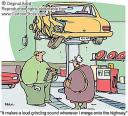Making sense of chaotic Spanish drivers.
Posted on marzo 3rd, 2008 leslie dean brown
You may not be able to think of anything more chaotic than a crazy spanish freeway, and in many cases you’d be absolutely darn right. But there is an underlying order in chaos, and this is what I’ll attempt to extract and share with you here. As many regular readers know, after many delays, I recently obtained my Spanish driving license, so I’m in a unique position to make sense of it all now. Far from being totally random, vehicle movements on Spanish roads are actually quite predictable when you can recognise the patterns:
- At high speeds, spanish drivers prefer to swerve rather than initiate abrupt braking manouvres. This avoids the chances of a pile up caused by multiple rear-end collisions. It increases the risk of crashing into everything else, but never mind that.
- To aid the fluidity of dense, high-speed traffic, giving way to merging traffic is not advised. Instead, spanish drivers help them to incorporate onto the freeway by changing lanes, but only if there is an opportunity. Otherwise they’ll shoot straight through without slowing. The rationale: why molest all of the cars behind you for the sake of a few in an entrance lane?
- To further aid the fluidity of dense traffic, drivers are taught from the very beginning to use the right lane unless overtaking. Except that this rule is not merely reccommended, it’s truly extolled here in Spain, being drummed into all driving students by all driving instructors for hours on end.
- Unfortunately, Spanish highways have become so clogged, that travelling in the right lane inevitably means encountering slower moving vehicles within less than 20 seconds’ time. And because the Spanish are usually running late for their appointments, there is also an overwhelming presence of Spanish drivers in a hurry to get somewhere. Hence, you’ll encounter a wide spread of driving velocities, from the achingly slow to the dangerously fast. Simple explanation? In Spain, there is always some schmuck in more hurry than yourself, so you can’t stay in the left lane very long either…
- What all this means in real terms is that Spanish drivers change lanes more times in one hour than they change their underpants in a whole year.
- Tailgaiting, affectionately known here as «tocando los cojones», serves one purpose only: to intimidate other drivers and force them to drive in the ‘slow’ lane. Believe it or not but flashing your lights in such situations is actually permitted by Spanish law. The fact that you may well be doing exactly the speed limit and the offending vehicle has no right to go any faster is simply not relevent (note to the spanish: don’t even dare try flashing your lights in other countries like Australia; it usually makes the driver in front slow down on purpose)
- On a more serious note, perhaps the best highway code is this: if you stop for any length of time on a highway or inter-urban road, you must wear a fluorescent yellow safety jacket. Spanish law further stipulates that safety jackets must stored in location where they can be accessed from inside the vehicle, and that they must be also worn before stepping out of the vehicle. This rule applies to everyone who exits the vehicle -day or night- no exceptions. Every car in Spain is equipped with at least two reflective safety jackets. Just peek inside the glovebox next time you hire a car in Spain. You’re also required to erect at least one safety triangle (depending on the road), which are usually stored in the boots of most cars.
- In Spain, luckily for me, cyclists are highly respected road users, so all drivers must give them adequate space when overtaking.
- On the other hand, pedestrians have zero wheels, and are therefore not considered vehicles of any sort. Unfortunately, stopping for pedestrians is not a common courtesy in Spain; the only exception is the actual driving exam when you must stop for them at all costs or face an immediate suspension.
- Giving way to merging buses for the common courtesy of all those people travelling on board is also a custom that is yet to appear widespread in Spain. People only catch the bus here if they can’t afford to travel by car. There is no «let’s travel by public transport even though we own a car» mentality. Since catching the bus is not seen as a necessity, cars never give way to buses.
- Here in Tenerife, the highways are generally full of traffic during the day and there are no alternate highways, so when maintenance needs to be done, there is no possibility of closing any roads or diverting any traffic via detours. Hence, all major road works occur at night time when there is the least amount of traffic, while several lanes remain closed. You’ll often see many workmen with their high-power lights and roadworks machinery working well into the early morning hours; unfortunately, this can also equal significant delays after peak hour(s) subside. I can say that due to increased labour costs, you’ll never ever see Australian roadworkers at night time, not in a million years.



Discussion Area - Leave a Comment